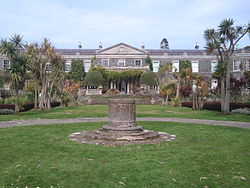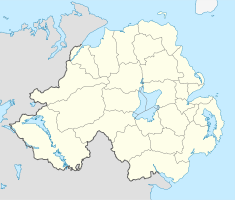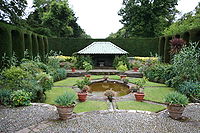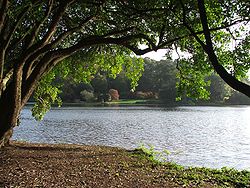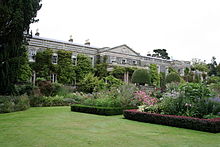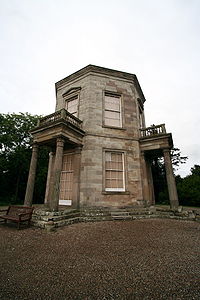- Mount Stewart
-
For other uses, see Mount Stewart (disambiguation).
Mount Stewart Mount Stewart, April 2011Coordinates: 54°33′18″N 5°36′29″W / 54.555°N 5.608°WCoordinates: 54°33′18″N 5°36′29″W / 54.555°N 5.608°W Built: 1820 - 1839 Built for: Marquess of Londonderry Architect: George Dance, William Vitruvius Morrison Listed Building – Grade A Designated: 20 December 1976 Reference #: HB24/04/052 A Register of Parks, Gardens and Demesnes of Special Historic Interest Mount Stewart is an 18th-century house and garden in County Down, Northern Ireland, owned by the National Trust. Situated on the east shore of Strangford Lough, a few miles outside the town of Newtownards and near Greyabbey, it was the home of the Vane-Tempest-Stewart family, Marquesses of Londonderry. The house and its contents reflect the history of the Vane-Tempest-Stewarts, who played a leading role in British and Irish social and political life.
Contents
History
Mount Stewart was formed by the Stewart family (later Vane-Tempest-Stewart), holders of the title Marquess of Londonderry since 1816. The family bought the estate in 1744 with money acquired by Alexander Stewart (1699–1781). This new wealth came from the sales of materials like linen. At the time, the house was known as Mount Pleasant.
Alexander Stewart's son, Robert Stewart, became the first Marquess of Londonderry. In about 1800 he added a temporary wing to the west. He died in 1821 leaving the house to his son, also Robert, better known as Viscount Castlereagh, a prominent politician. Robert lived in Mount Stewart during his childhood until he went to University in Cambridge.
Lord Castlereagh inherited his father's title only a year before his own death. The next owner of the house was his half-brother, Charles, 3rd Marquess of Londonderry (1778–1854). He married twice but it was his later marriage which increased the family's finances greatly. His second wife was Lady Frances Anne Vane-Tempest. She was the greatest heiress of her time.[citation needed] This huge new wealth prompted the refurbishment and enlargement of the newly renamed Mount Stewart. Controversially the Londonderrys, while spending £150,000 on the refurbishment only gave £30 to famine relief in Ireland in the 1840s, despite the fact that the Londonderry estates were directly affected by starvation.[1] This remodelling created the present exterior of Mount Stewart. The small Georgian house and the small portico on the west wing were demolished and the house was increased to eleven bays. On the entrance front, a huge portico was added in the centre, and a smaller 'half portico' was added to the other side.
The marriage also brought in much of the Vane-Tempest property, including land. Wynyard Park in County Durham was also redesigned in the Neo-classical style. The couple bought Seaham Hall, also in County Durham, and then later bought Holdernesse House on London's Park Lane. This was later renamed Londonderry House.
The 4th Marquess of Londonderry married the widow of Viscount Powerscourt and lived at her home, Powerscourt, near Dublin. The 5th Marquess lived at his wife's ancestral property, Plas Machynlleth in Wales, and his son, the 6th Marquess, lived at Wynyard. These long periods of neglect nearly destroyed Mount Stewart.
The 7th Marquess (1878–1949), a well-known Ulster Unionist politician, and his wife brought a new lease of life to the house and its plain grounds. The Marchioness of Londonderry's ancestral home was Dunrobin Castle in Scotland and it was that house's gardens which inspired the Mount Stewart's. She also redesigned and redecorated much of the interior, for example, the huge drawing room, smoking room, the Castlereagh Room and many of the guest bedrooms. She named the latter after European cities including Rome and Moscow.
The Gardens
After the house's interior, the Marchioness redesigned the gardens in the most lavish way possible. Prior to her husband's succession to the Marquessate in 1915 the gardens had been plain lawns with large decorative pots. She added the Shamrock Garden, the Sunken Garden, increased the size of the lake, added a Spanish Garden with a small hut, the Italian Garden, the Dodo Terrace, Menagerie, the Fountain Pool and laid out walks in the Lily Wood and rest of the estate. In 1957, she gave the gardens to the National Trust.
The National Trust
The National Trust took over the gardens in 1957. The last chatelaine of the house (and the last surviving child of the 7th Marquess), Lady Mairi Bury (née Vane-Tempest-Stewart, Dowager Viscountess Bury), gave the house and most of its contents to the Trust in 1977. The Trust operates the property under the name "Mount Stewart House, Garden & Temple of the Winds". Lady Mairi Bury was the last Londonderry family member to live at Mount Stewart, and the last member of this Anglo-Irish family to live in Ireland when she died at Mount Stewart on 18 November 2009, at the age of 88.[2][3][4][5]
In 1999 the Mount Stewart Gardens were added to the United Kingdom "Tentative List" of sites for potential nomination as a UNESCO World Heritage Site.[6]
The House
Mount Stewart had many good and bad times. It was in almost permanent use when the 3rd Marquess was alive and was greatly extended to become the principal family residence. It was increased in size greatly with a collection of new rooms which were suitable to house the family's growing art collections, furnishings and general treasures. The main room was (and still is) the 'Drawing Room'. This looks out onto the main gardens and in the past it would have been possible to see Strangford Lough. Another main entertaining room was the 'Dining Room' which looks out onto the entrance front and was almost twice its present size, but was altered to make a new kitchen some time after its construction and lavish decoration. One of the most stunning rooms at Mount Stewart is that of the private 'Chapel'. This hidden gem is a double-height room with stained glass windows and Italian paintings on its walls.
The Estate
The present-day estate of Mount Stewart extends to 98 acres (40 ha) with a large lake and many monuments.
The Temple of the Winds
This octagonal building was inspired by the Grand Tour the 1st Marquess took in his youth. Many country houses in the UK had adaptations of the 'temples' their owners had seen on their tours of the Mediterranean . It is similar to ones at Shugborough and West Wycombe Park, both National Trust properties.
Tir Nan Nog
This is the Vane-Tempest-Stewart's burial ground. The 7th Marquess and his wife Edith, Lady Londonderry, are buried here. Around it are statues of Irish saints.
Scrabo Tower
This tower was built in honour of the 3rd Marquess. It was commissioned by his son Frederick, the 4th Marquess, and his stepmother, Frances-Anne Vane-Tempest Stewart. It affords views over Strangford Lough.
See also
- Dunduff Castle, South Ayrshire, property of the ancestors of the Stewarts of Mount Stewart
Other residences of the Marquesses of Londonderry:
- Londonderry House in London
- Plas Machynlleth in Wales
- Seaham Hall in County Durham
- Wynyard Park in County Durham
- Loring Hall in Kent
References
- ^ University College Cork records on the Irish Famine
- ^ http://thescotsman.scotsman.com/obituaries/Lady-Mairi-Bury-of-.5847291.jp
- ^ "Lady Mairi Bury: Chatelaine of Mount Stewart who met Hitler and Von Ribbentrop". The Independent (London). 27 November 2009. http://www.independent.co.uk/news/obituaries/lady-mairi-bury-chatelaine-of-mount-stewart-who-met-hitler-and-von-ribbentrop-1828369.html.
- ^ http://www.irishtimes.com/newspaper/obituaries/2009/1212/1224260585294.html
- ^ "Lady Mairi Bury". The Daily Telegraph (London). 13 January 2010. http://www.telegraph.co.uk/news/obituaries/6983261/Lady-Mairi-Bury.html.
- ^ "Mount Stewart Gardens". UNESCO. http://whc.unesco.org/en/tentativelists/1327/.
External links
- Mount Stewart House, Garden & Temple of the Winds information at the National Trust
- Virtual Tour of Mount Stewart House & Gardens Northern Ireland - Virtual Visit Northern Ireland
National museums Northern Ireland Environment Agency Ballycopeland Windmill · Bellaghy Bawn · Carrickfergus Castle · Castle Archdale Country Park · Derry City Walls · Devenish Monastic Site · Dundrum Castle · Dunluce Castle · Greencastle · Grey Abbey · Harry Avery's and Newtownstewart Castle · Hillsborough Courthouse · Inch Abbey · Jordan's Castle · Monuments and Buildings Record · Navan Fort · Nendrum Monastic Site · Tullaghoge · Tully CastleNational Trust Ardress House · The Argory · Carrick-a-Rede Rope Bridge · Castle Coole · Castle Ward · Crom Estate · Crown Liquor Saloon · Derrymore House · Downhill Estate (Mussenden Temple) · Florence Court · Giant's Causeway · Gray's Printing Press · Hezlett House · Mount Stewart · Murlough Nature Reserve · Patterson's Spade Mill · Rowallane Garden · Springhill House · Wellbrook Beetling MillOther museums and galleries Categories:- Gardens in Northern Ireland
- Buildings and structures in County Down
- Houses in Northern Ireland
- National Trust properties in Northern Ireland
- Historic house museums in Northern Ireland
- Museums in County Down
- Register of Parks, Gardens and Demesnes of Special Historic Interest
Wikimedia Foundation. 2010.

